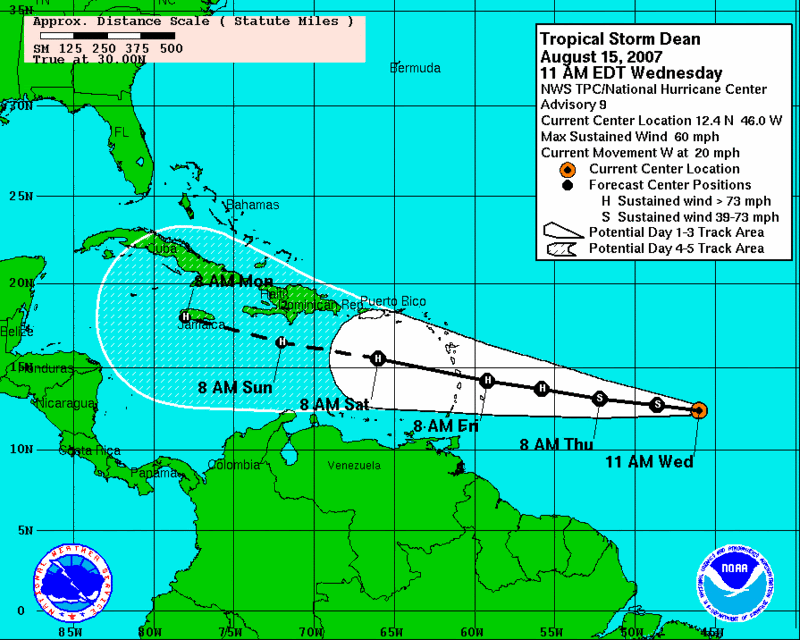Hurricanes and the VIX
Lest anyone wonder, I was absolutely kidding when I decided to append the “Your one stop VIX-centric view of the universe…” tagline to this blog when I created it. That doesn’t mean, however, there might be more than a little truth embedded in the tagline.
I had planned to talk at considerable length about hurricanes and the VIX during the past month, recognizing that August is when tropical activity typically kicks in to high gear. Given all the non-weather volatility we’ve had, it looks like I’m going to need a lot more back burners to hold all those boiling pots.
Speaking of which, we now we have tropical storm Dean bearing down on the
As Dean approaches, I will opine more about the potential VIX and oil-related trades (I’m going to keep it simple and skip the insurance and other aspects of this gambit) that are possible with oncoming hurricanes. Keep in mind that while
Interested in a tool for viewing and evaluating hurricane tracks? Try the NHC archive of hurricane seasons.
Finally, consider that unlike most financial storms, the duration of the disruption caused by a hurricane strike is fairly easy to predict, which makes mean reversion plays all the more attractive. This is something to think about, anyway, as Dean whips up fears that will likely be out of proportion to the probabilities times the magnitudes of the various possible scenarios.



4 comments:
I see on the probabilities table that Miami is the most likely location for a hurricane to hit. Now wouldn't it be ironic if Dean (or another future hurricane) were to effectively bail out the condo owners/developers in that overbuilt city?
Eric
OT,
Bill, do you think that it is possible we could see another -9 or -10 on the VWSI?
What would that take?
Hi Robert,
Perhaps I should just reserve a table for you by the window for 4:00 p.m. every day?
Regarding the VWSI, my predictions have been way off for the last two weeks, but that should only slow me down a little going forward.
While the VWSI gets reset each day to reflect the day's trading activity, with today's 30.67 close (it drifted down a little from 4:00 - 4:15), I calculate a projected end of week VWSI of -10 at 33.09 or above and -9 at 30.97. Today's 30.67 is a -7, just above the break point of 30.64.
Frankly, the more I watch the tape, the more I'm beginning to think that one or more large financial institutions is in trouble; and with all the support levels that were broken today, there are fewer safety nets to go around.
To answer your question about a VWSI of -9 or below going into the weekend, it certainly is possible. At the moment I would give it about a 40% probability, given the propensity that traders and portfolio managers have displayed for loading up on options going into the weekend to protect against headline risk.
FWIW, I think today was the biggest victory the bears have had yet, but I'm not sure how much mileage they can get out of it going forward.
Cheers and good trading,
-Bill
Hurricanes are among the most powerful and destructive natural disasters, impacting economies, communities, and the environment. The Volatility Index, is often referred to as the "fear index" and measures market volatility based on the expected fluctuations of the S&P 500 index options.
body massage in bangalore for men
Post a Comment